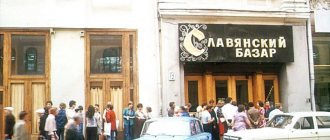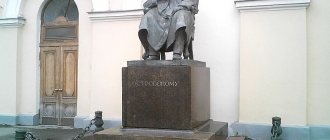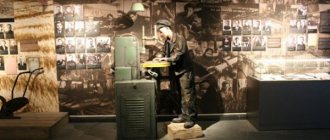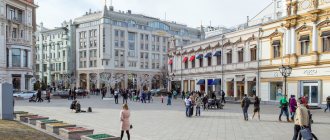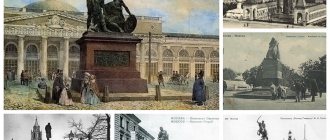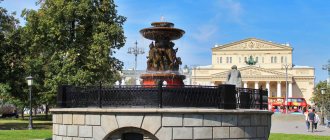Monument to homeless animals in Muzeon
Photo: Sofya Sandurskaya (AGN “Moscow”)
Photo: Sofya Sandurskaya (AGN “Moscow”)
Photo: Sofya Sandurskaya (AGN “Moscow”)
On October 4, World Animal Day, a monument to homeless animals was unveiled in the Muzeon art park. It became a call for mercy, cast in bronze: the sculptural composition depicts a mongrel with a piercing gaze, who lies and warms herself on a sewer hatch, and next to her lies an old tattered shoe. According to the original project, the monument was supposed to be at the same time a piggy bank to collect donations from people who are not indifferent to the fate of homeless animals and send them to the needs of animal shelters. But according to the law, the installation of such structures in parks and public recreation areas is prohibited, so the sculpture has neither a bowl nor a hat where one could throw coins. But the initiator of the project, the Givers of Hope Foundation, still hopes that the monument to the mongrel will do its job, and people passing by will remember how many four-legged animals are around who need help, a home and human warmth.
st. Krymsky Val, ow. 2
View on map
Sculpture “Sympathy” on Mendeleevskaya
Photo: Aleksb1
Photo: Voyagerim
The story of the appearance of the bronze monument in the under-street passage of the Mendeleevskaya metro station is very tragic. The boy's name was a homeless mongrel. A stray dog lived in an underground passage - at that time the capital had a program for the free presence of stray sterilized animals on the city streets. In December 2001, the Boy was brutally killed by Muscovite Yuliana Romanova, the owner of a Staffordshire terrier. Now it’s impossible to find out what happened: the mongrel barked at a purebred dog or Romanova purposefully set her “fighter” on the stray dog... The terrible incident ended in the death of the Boy: the owner of the staff inflicted several stab wounds on him. Later, the court found out that the girl suffered from schizophrenia and sent her for compulsory treatment to a psychiatric clinic. The dog could no longer be returned, but animal rights activists, public activists and people simply sympathizing with the Boy began raising funds to create a monument. Its authors were sculptor Alexander Tsigal, architect Andrei Nalich and designer Peter Nalich (we know him better as a musician and songwriter). A bronze sculpture of a dog - this is not a Boy, but a collective image of a Moscow mongrel - was installed at the entrance to the metro lobby. There is an inscription carved on the pedestal that fully reveals the meaning of the monument - “Sympathy. Dedicated to humane treatment of stray animals."
st. Novoslobodskaya, 23
View on map
LiveInternetLiveInternet
We continue our review of monuments to dogs Let's look at monuments to military dogs, helper dogs, favorites, literary dogs... Monuments to military dogs Monuments and memorials in many cities around the world are dedicated to dogs that help people in war.
Military Dog Memorial in Long Island, New York This Military Dog Memorial opened in 2005 and is dedicated to all dogs that served as military, police, search and rescue dogs.
The monument is intended to remind of dogs - heroes, thanks to whom countless lives have been saved. Some of them gave their lives to save people in wartime, searchers and rescuers worked on the day of the September 11 tragedy, and work during rescues during natural disasters. On the territory of the American island of Guam, monuments to military signal dogs have been erected.
On the pedestal is a copy of Kurt's deceased Doberman "Animals at War" - a memorial in London dedicated to the memory of all the animals that "served and died in British and Allied forces in wars and conflicts throughout time." The sculptor of the monument, David Backhouse, said that he could not remain indifferent to the fact that during the wars of the last century, 15 thousand carrier pigeons died, 8 million horses died in the First World War alone, and dogs saved the wounded under enemy fire. The memorial has two levels, separated by a wall with bas-reliefs. At the lower level of the memorial, two loaded bronze mules walk into a passage in the middle of the wall.
On the upper level, there is a bronze horse and dog passing through the passage; the dog looks around in search of its owner.
On the wall there are bas-reliefs depicting: carrier pigeons, a dog, camels, horses, an elephant, a mule, a cow, a cat. Below the main inscription “ Animals at War ”, there are two more inscriptions. “ This monument is dedicated to all the animals who served and died in British and Allied forces in wars and conflicts throughout time .” And “They had no choice”... On the wall is a bas-relief of the Mary Deakin medal - the British military medal for animals. This medal was first awarded in 1942 and has since been awarded to 62 animals, including dogs, pigeons, horses and one cat.
Monument to the Yorkshire Terrier Smokey In 2005, a monument to the smallest and most famous dog of the Second World War, the Yorkshire Terrier Smokey . The baby, weighing 2 kg, endured the hardships of military service with her owner for 2 years, was enrolled in an air regiment, made sorties and parachute jumps, and was awarded 8 stars and the rank of corporal. Smokey was named the Mascot of the Southwest Pacific for 1944. But Smokey was more than a mascot. He helped signalmen when laying cables, helped in hospitals, entertaining wounded soldiers in hospitals... Smokey died in 1957. A monument in honor of Smokey, a small hero of World War II, is located in Cleveland, Ohio. Judy number POW81A Judy was a ship's pointer dog who served on the British gunboats HMS Nat and HMS Grasshopper. Judy barked to warn of the approach of enemy aircraft before they were detected by the guards. In February 1942, the ship was attacked by Japanese bombers and was sunk. The surviving crew reached the island. Using her instincts, Judy found sources of fresh water , thereby saving the crew from death. But the Japanese took the sailors prisoner and sent them to a concentration camp. Judy was the first dog to be officially registered as a prisoner of war during World War II and was assigned the number POW81A . While in captivity, Judy met her new master, pilot Frank Williams. During the crash of a ship carrying prisoners, Judy managed to survive and help people stranded in the water by pushing floating objects toward them. She was later awarded the Mary Deakin Medal, the highest military award for animals.
Judy died in 1950 in Tanzania, where her owner Williams was working. At her grave near Lake Tanganyika there is a granite monument with a tablet describing her exploits. In addition to several bullet wounds, she had to survive fights with alligators, and even a Sumatran tiger. Great Dane - Sailor In the city of Cape Town (South Africa), in the Central Square, there is a monument to the dog - a Great Dane cast in bronze. His paws have a sailor's cap and a collar.
The sign says: “ Sailor of the first article Great Dane Just Nuisance, 1937 - 1944.” The dog was a favorite of the sailors who served at the naval base in Simontown. …………..
Russia Dogs in War During the Great Patriotic War, about 70 thousand dogs served in the Red Army, which saved the lives of many soldiers. The dogs were scouts, sentries, signalmen, they stretched telephone cables, found mines, and delivered ammunition to soldiers. The most famous are the dogs Dina and Dzhulbars , fighters of the 14th assault engineer brigade. Dina is a mine detector and saboteur dog. In the fall of 1943, the brave mongrel managed to blow up an enemy train and survive. Dzhulbars participated in mine clearance in Czechoslovakia, Hungary and Austria. The dog saved architectural monuments during the demining of palaces and castles in Europe. Dzhulbars discovered 7468 mines and more than 150 shells.
The unique dog was awarded the medal “ For Military Merit” and took part in the Victory Parade, lying on Stalin’s jacket : the red mine detector was wounded.
about Dina and Julbars here:
Monument to a front-line dog - erected in Moscow on Poklonnaya Hill. During the war years, mine detection dogs found more than 4 million mines.
The sculpture of a shepherd dog is made with a bag on its back, in which the dogs carried medicine during the war, its paws lie on the torn tracks of the tank, in memory of the demolition dogs.
On May 12, 2021, a monument to military trainers and service dogs of the Leningrad Front was unveiled in the Sosnovka forest park in St. Petersburg.
The monument was erected in memory of the “Girl Team,” as the 34th Mineral Engineer Battalion was called during the war. During the war and blockade, in the Sosnovka forest park there was a school-kennel for the service dog breeding of the NKVD of Leningrad. Here dogs were trained for the sanitary service and communications service, and were trained to search for mines. The soldiers of the 34th battalion neutralized over half a million mines.
The monument “Military Instructor with a Dog ” was erected in 2009 in Moscow in the Terletskaya Oak (Novogireevo metro station, Svobodny Prospekt) in honor of the dogs that helped soldiers on the battlefields during the Great Patriotic War.
There were signal dogs, sapper dogs, orderly dogs, and sled dogs. But the most dangerous and tragic fate was that of tank destroyer dogs. They delivered explosives to an enemy tank. Monument to demolition dogs, tank destroyers (Volgograd) On May 28, 2011, on the day of the border guard, a monument to tank destroyer dogs was erected on Chekistov Square. In the Battle of Stalingrad, dogs burned 63 enemy tanks - an entire tank battalion. The feat of the 28th detachment of demolition dogs of the 10th NKVD division is well known.
The detachment destroyed 2 armored vehicles, 42 tanks, hundreds of enemy officers and soldiers. However, feat always has a downside. Out of 202 people and 202 dogs, 148 dogs and 148 people died from August to October... Only 54 fighters survived along with their four-legged comrades. Monument to heroic doctors and ambulance dogs , Essentuki At the front, medical dogs crawled up to the wounded and offered a medical bag so that the soldier would bandage the wound. Dogs also worked in sleds.
The monument is a snow-white sculpture of a military nurse standing in full-length uniform. Next to her stands a dog, a faithful friend and helper in difficult times. Plaque: “Dedicated to the heroic doctors and ambulance dogs who saved thousands of soldiers’ lives.”
Jack . Monument to service dogs who died in the line of duty. Novosibirsk The prototype for the creation of the sculpture was a shepherd dog named Jack , who, together with his owner, made five business trips to Chechnya and died in the line of duty.
Jack's task was to search and locate explosives, weapons and ammunition. The shepherd has saved many lives.
Sculpture "Drum Dogs"
Drum dogs of Duke Charles's infantry regiment.
Drum Dogs - History
On Kashtanovaya Alley street in Kaliningrad there is a sculpture depicting dogs with drums. The Austrian 77th Infantry Regiment had dogs that performed a “musical” function - they drove a cart with a large drum.
In 1866, the dogs were "captured" by a Prussian infantry regiment. The soldiers and residents of the city liked the St. Bernard dog, and it was decided to accept it into service. Dogs took part in marches and holiday parades. In April 1945, during the assault on Konigsberg by Soviet troops, the officer who had a St. Bernard first shot his pet, his wife and children, and shot himself………….. Dogs - assistants to rescue assistants in Moscow Monument to rescuers and dogs - rescue assistants , who saved many lives by searching for victims under the rubble.
It is installed near the Slavyansky Boulevard metro station.
In Holland, the most famous dog is the shepherd Leo . This dog worked at Amsterdam Airport for 9 years and found several million dollars worth of drugs.
With its help, customs officers managed to detect drugs in more than 300 people. In total, Leo discovered 3 tons of hashish, 1 ton of marijuana, 30 kg of heroin and 18 kg of cocaine. All this was transferred for processing into medicines. Leo was awarded a state prize. Yakutsk Monument to the Yakut Laika Strong, unusually hardy, intelligent and obedient Yakut Laikas were used to transport people and goods over long distances in the North and for hunting.
And today the Yakut Laika is one of the best sled dogs. ……. Left behind in Antarctica In July 1958, a monument to the sled dogs left behind at the Japanese Antarctic Station Showa was unveiled Tokyo Due to the storm, only people were saved. It was decided to erect a monument to the dead dogs. The monument was unusual, group. Behind a metal fence, on the platform, fifteen marble dogs were sitting and lying.
A year later, another expedition arrived at Syova station. She was greeted by two live huskies (Taro and Jiro). They were able to free themselves from their bonds, and lived on the island without people for a year. At the same time, they did not touch their dead comrades and lived, having learned to hunt penguins. In Japan, this news was greeted with jubilation. ………….. In St. Petersburg in 2021, near the building of the Arctic and Antarctic Research Institute on Bering Street, a monument to domestic polar explorers was unveiled, and dogs were not forgotten.
In Copenhagen in 1912, sculptor Kay Nielsen, when erecting a monument to the dead Danish polar explorers, did not forget the dogs. And every decade, for three days, there is a guard of honor near the monument: people, and next to them – dogs.
Rescuer Ajax . Once in the Duckstein mountains (Austria), an avalanche overtook 11 schoolchildren and two teachers on their way. Ajax also worked with the rescue group for 96 hours . Despite frostbite and wounds, Ajax tore through the snow, helping rescuers find people. ……… Guide dogs
In Germany, as a token of gratitude for helping people, a monument was erected to guide dogs on the territory of the Berlin Zoo. (1980s).
In many countries around the world, schools for training guide dogs have been established. One of them exists in the Moscow region. Such a dog must be able to warn the owner in time about the steps of the stairs, lead him around an oncoming obstacle, and wait for passing traffic. Sydney . Donna is listed in the Guinness Book of Records as the longest living guide dog. She served her master faithfully.
Guide dogs live shorter lives than other service dogs. Constant neuropsychic stress takes its toll…………………
PETS Monuments to dogs - companions and pets of famous and not so famous people
Yale (d. 1922) was the pet dog of King Vajiravudh of Siam, known as Rama VI.
She was shot by unknown assailants, as a result of which the king fell into deep sadness, organized a magnificent funeral for her and erected a tombstone.
in Nesvizh Park . A greyhound sits on a stone pedestal and looks intensely into the distance.
Radziwill’s favorite , and he, experiencing the loss, decided to perpetuate its memory. Islay Dog Monument is located next to the Queen Victoria in Sydney.
Nekrasov house-museum in Chudovo, there is a monument where Nekrasov is depicted with a gun and his beloved dog.
Not far from the house, and now there is a slab with the inscription: “ Kado, the Black Pointer, Was excellent in the hunt, An indispensable friend of the house .” Born June 15, 1862, killed by accident while hunting May 2, 1875″
Monument to the “Snow Dog”, which local residents presented to Simon Bolivar during his triumphant campaign from Colombia to Caracas in 1813.
The dog stayed with Libertador until 1821 and died during the Battle of Carabobo. They say that Bolivar sincerely mourned the loss. The monument reflects the love Venezuelans have for Bolivar.
Roosevelt and Fala Memorial to US President Franklin Delano Roosevelt in Washington The memorial is made in the form of a labyrinth with artificial waterfalls and various other structures. The sculptures in the Roosevelt Memorial reflect typical social problems that Roosevelt struggled with - unemployment, shortages, etc.
Roosevelt himself is depicted with his Scottish terrier named Fala.
Fala accompanied Roosevelt on many of his official trips. In addition, his name was used by US Army soldiers as a password during the Bulge. Fala died in 1952 and was buried next to Roosevelt. Fala was the subject of Alan Foster's Mr. White House cartoon series.
Australia was discovered for a long time and in parts. In 1851, gold mines were discovered in Victoria, and a powerful stream of settlers poured in. Dogs were used to guard the wagons. The gold rush has long passed, but songs about the life of settlers, gold miners, their friends and guard dogs remain in memory. And in 1932, on the Melbourne-Sydney , in the city of Gandagai , a monument was erected to the dogs who were the companions and helpers of their ancestors. A team of miners from the city of Berezovsky, Kemerovo region, raised money and erected a monument to the deceased dog Lyalka .
For more than 15 years in a row, every morning she came to the Pervomaiskaya mine exactly at the beginning of her shift and went down to the face with the miners. ………………. Literary monuments The world-famous fairy tale involving a dog - The Bremen Town Musicians of the Brothers Grimm. The heroes of the fairy tale - a donkey, a dog, a cat and a rooster - go to the city of Bremen. The monument in Bremen is a symbol of the city.
Mumu Turgenev Monument in St. Petersburg
. And at the entrance to the Kiev Puppet Theater, faithful Artemon protects Malvina .
There are many literary monuments, several are shown here, and the rest will be discussed in the next part. ……………
China The Sacred Lion is of great importance in Buddhism . And since there are no lions in China, this animal began to be personified by dogs with manes resembling a lion - Pekingese , Lhasa Apso, Shih Tzu , Chow Chow . Images of such dogs were installed in front of the entrance to temples and in the Forbidden City near the imperial palace.
Pekingese is a dog breed that was bred at the court of the Chinese emperor and was kept secret for a long time. Taking them outside the palace was punishable by death. Shih Tzu (lion dog, chrysanthemum dog). Until the 20s of the 20th century, dogs of the Shih Tzu (Shih Tzu) breed were also forbidden dogs of the court of the Chinese emperor. Shih Tzu is translated from Chinese . And the Shih Tzu at heart is not a small dog, but a large and formidable lion. According to legend, such dogs accompanied Buddha and Confucius on their travels. This little dog was lion at any moment . As a symbol of Tibet , snow lions (that’s what they are called there) are depicted on the national flag of the Land of Snows. They are also called “Lions of Buddha”, sometimes “Dogs of Buddha”.
Shi-Za in St. Petersburg On Petrovskaya Embankment
On Liteiny Prospect in the Garden of Friendship
Dogs of Okinawa Such sculptures can also be seen on the Japanese island of Okinawa . The creature is called a shisa , a cross between a lion and a dog. Okinawans place figurines on the roofs of houses or near the entrance.
According to legend shisa , brought from China as a gift to the king, saved people from a terrible dragon. The king remembered the priestess's prediction - to use the gift from China, and went to meet the dragon, raising the dog above his head. Seeing the unknown beast, the dragon let out a menacing roar. The loud sound caused the earth to tremble, a piece of rock broke off and crushed the dragon. Since then, the shisa dog has become a national hero in Okinawa. Monuments to the she-wolf Let us note that “wolf” and “dog” are sometimes identified and in myths about the wolf it is characterized by its closeness to the mythological dog . Who doesn’t know the legend about the Capitoline she-wolf who suckled the brothers Remus and Romulus?
The Etruscan bronze sculpture is located in the Capitoline Museum in Rome (beginning of the 5th century BC. Romulus and Remus were added in the 15th century). And its copies decorate many cities around the world: in Australia, Japan, Spain, Brazil, France, Russia.
…………
Urban sculpture of Salamanca In the carvings of the Cathedral of Salamanca (Spain), 12th century, you can find the figure of an astronaut in a spacesuit.
But there is no mysticism here: the figure was added in 1992 during restoration by one of the masters as a signature (he chose the astronaut as a symbol of the 20th century).
Maastricht, Netherlands "Buy cigarettes"
This is a monument to children who, in the first years after the end of the Great Patriotic War, sold cigarettes to get bread. Signs of the Moscow metro The sculptural compositions at the Ploshchad Revolyutsii were created by Matvey Genrikhovich Manizer. The arches contained 80 bronze sculptures made in the Leningrad art casting workshop. “Revolution Square” is a kind of memorial: cast characters - from heroes of the Civil War and Revolution to peaceful workers - personify the stages of the creation of the Soviet Union, the strength and power of the young Soviet state.
The sculpture “Scout with a Dog” is the third carriage from the end towards Shchelkovskaya. To successfully pass the exam, the dog's nose is rubbed, and to pass the test, the dog's paw is shaken. This belief has been known since 1938 and was invented by students of the Moscow State Technical University.
The “Sympathy” monument is located near the Moscow metro station “Mendeleevskaya” and is dedicated to humane treatment of stray animals. Installed in 2007. The monument is dedicated to a stray dog named Boy, who lived in an underground passage near the Mendeleevskaya metro station and died as a result of the conflict in 2001.
The incident occurred when dog breeder Yu. Romanova entered an underground passage with her Staffordshire terrier. Unable to separate the grappling dogs, Romanova took a knife from her bag and stabbed the “Boy”. A criminal case was opened. The court ordered Romanova to undergo compulsory treatment.
Stray dogs In 2010, a monument to a homeless dog was inaugurated on a voluntary basis Tyumen The monument is a piggy bank. All money goes exclusively to the animals. Several additional enclosures were built for them, and the rest of the money goes towards treatment.
A pleasant surprise is the fact that the piggy bank contains both large bills and coins from different countries, which indicates the concern of foreign guests of the city. Dog on the Pritomskaya embankment Kemerovo Embankment of the Tom River A homeless mongrel warms himself on a warm manhole cover in winter.
“If there is not enough warmth From human hands, It is unlikely that it will be replaced by a Porch or a warm hatch. Don't pass by the Dog's sad eyes! This is unacceptable: Abandoning those who love us.”
Monument to a homeless dog in Orenburg.
Monument to an abandoned dog in Sosnovoborsk. A full-length image of an Irish Setter dog was recreated from polymer concrete.
On the pedestal of the monument there is an inscription: “You are responsible for those you have tamed.”
Kostroma For more than a hundred years, there has been a legend about the Kostroma dog. She lived in the city at the end of the 19th century in the fire department. Bobka the dog was part of the local fire brigade. He always accompanied firefighters on field trips, helping to pull people or things out of the fire.
In 2007, a bronze monument to Bobka appeared. Later, a piggy bank in the shape of a ball was placed next to the monument, into which Kostroma residents and city guests throw money for the animal support center. ………….. There are a huge number of monuments to dogs in many cities around the world, it’s impossible to see them all. But we’ll look a little more in the next review of “Dogs in Art.” To be continued! Sources https://polsergmich.blogspot.com/2012/09/blog-post_29.html https:// curious -world.ru/index.php/mir/puteshestviya/item/148-pamyatniki-sobakam-v-rossii- chast-1 https://www. dogocanario-forum.ru/showthread.php?t=858 https://ru.wikipedia.org/wiki/Category:Monuments to dogs
And also earlier in the diary about the symbol of 2021: Dogs are the symbol of the year 2021 part 1 Dogs in myths, legends They were the first in space
Monuments to dogs - the symbol of the year 2021 part 1 …………….
………….
A soldier with a dog on Revolution Square
Photo: Shutterstock
Photo: Shutterstock
The underground lobby of the Revolution Square station is decorated with two rows of bronze figures. The most famous of them is a border guard with a dog. The dog had a real prototype. The luxurious German shepherd Irma lived in the house of Alexei Nikolaevich Dushkin, participated in exhibitions, and received awards. The dog died before the war, but its memory remained for many generations. The figures at the station are repeated, so there are four dogs here - two each on the right and left (on the vestibule side and on the platform side). The noses of all four are rubbed to shine and almost out of shape - too many people wishing to touch the dogs “for good luck” pass through the Arbatsko-Pokrovskaya metro station every day.
st. Nikolskaya, 8/1, building 1
View on map
Four-legged heroes of the Great Patriotic War
They walked with man, side by side, and in difficult times they came forward. They shared a trench and rations with a man. They worked and died instead of man. These are dogs, dogs in war.
During the Great Patriotic War, about sixty thousand dogs were drafted into the army, not only shepherd dogs, but also other breeds, including large mongrels. Of these, 168 units were formed. The most famous dogs are those that, hung with explosives, threw themselves under enemy tanks. Near Stalingrad, German tank crews, noticing kamikaze dogs jumping out of the trenches to meet them, turned back. During the war years, the dogs, sacrificing themselves, blew up more than three hundred German tanks. One of the dogs derailed an enemy armored train, and she herself remained alive - Dina jumped onto the rails in front of the train, laid a mine and at the very last moment rushed to the side.
The legend about Dzhulbars and Stalin's overcoat
There is a beautiful legend about Julbars. At the historical Victory Parade on July 24, 1945, all fronts of the Great Patriotic War and all branches of the military were represented. Following the combined regiments of the fronts, the regiment of the Navy and columns of military equipment, dogs walked along Red Square with their handlers.
At that historical parade, the country’s chief dog handler, Lieutenant Colonel Mazower, walked behind the “box” of soldiers with dogs. He was allowed not to mark a step and not to salute the commander-in-chief, since he was carrying in his arms a soldier of the 14th assault engineer brigade - a dog named Dzhulbars. The four-legged fighter took part in battles and clearing terrain in Romania, Czechoslovakia, Hungary and Austria. There, Dzhulbars discovered 468 mines and 150 shells, for which he was nominated for a military award - the medal “For Military Merit”. By the day of the historical parade, Dzhulbars had not yet recovered from his injury. They say that he was carried on the tunic (overcoat) of Stalin himself.
Feats of dogs in the Great Patriotic War
Whether this is true or not, I have no one to ask, but the dog handlers were walking around the square. It is a fact. And dogs took an active part in the Great Patriotic War. In total, along the military roads from Moscow to Berlin, 68 thousand Sharikov, Bobikov and Mukhtarov crawled, walked, drove and ran: pedigree and not so, large and small, smooth and shaggy. They all made an invaluable contribution to this great cause.
The formation and development of service dog breeding in Soviet times is associated primarily with the name of the canine scientist Vsevolod Yazykov, the author of many books on the theory of training and the work of dogs in the military sphere. Looking ahead, I will say that his scientific methods formed the basis of the theory and practice of service dog breeding in the army, in the border and internal troops.
Back in 1919, it was Yazykov who first approached the Red Army Headquarters with proposals on the principles of organizing service dog breeding in the Red Army. But only five years later, on August 23, 1924, the Order of the Revolutionary Military Council of the USSR No. 1089 was issued, according to which a Central training and experimental nursery school for military and sporting dogs was organized in Moscow at the Higher Rifle and Tactical School “Vystrel”. Nikita Yevtushenko was appointed the first head of the school. The nursery was named “Red Star”. The center gave impetus to the creation of service dog breeding clubs in the OSOAVIAKHIM system, the predecessor of DOSAAF and ROSTO. Unfortunately, in 1938 Yazykov died in the crucible of Stalinist repressions. By the beginning of 1941, this school was training dogs for 11 types of services. The Germans stated with envy that “nowhere were military dogs used as effectively as in Russia.”
Sled and ambulance dogs
Dogs at war, dog war, Dzhulbars, dog handlers, Mazovers, dogs at war, dogs at the Victory Parade, dogs in the Great Patriotic War, service dog breeding, dog breeding in the Red Army, military dogs, sled dogs, ambulance dogs
Sled dogs and ambulance dogs - about 15 thousand teams, in winter on sledges, in summer on special carts under fire and explosions, took about 700 thousand seriously wounded from the battlefield, and transported 3,500 tons of ammunition to combat units.
From the memoirs of Sergei Solovyov, a participant in the Great Patriotic War from Tyumen: “Because of the heavy fire, we, orderlies, could not get to our seriously wounded fellow soldiers. The wounded needed urgent medical attention, many of them were bleeding. There were only a few minutes left between life and death... Dogs came to the rescue. They crawled up to the wounded man and offered him his side with a medical bag. They waited patiently for him to bandage the wound. Only then did they go to someone else. They could unmistakably distinguish a living person from a dead person, because many of the wounded were unconscious. The four-legged orderly licked the face of such a fighter until he regained consciousness. In the Arctic, winters are harsh, and more than once dogs saved the wounded from severe frosts - they warmed them with their breath. You may not believe me, but dogs cried over the dead..."
We know about Private Dmitry Trokhov. For three years, on a dog sled led by the husky Bobik, he took 1,580 wounded from the front line. He was awarded the Order of the Red Star and three medals “For Courage”. It is worth noting that the orderly for 80 people carried from the battlefield was awarded the title of Hero of the Soviet Union. This is perhaps the most heroic and most useful work of dogs.
Mine detection dogs
Mine detection dogs - there were about 6 thousand of them - were discovered, and sapper leaders neutralized 4 million mines, landmines and other explosives. Dogs at war, dog war, Dzhulbars, dog handlers, Mazovers, dogs at war, dogs at the Victory Parade, dogs in the Great Patriotic War, service dog breeding, dog breeding in the Red Army, military dogs, sled dogs, ambulance dogs
The Leningrad collie Dick is famous. In his personal file it is written: “Called up for service from Leningrad and trained in mine detection. During the war years, he discovered more than 12 thousand mines, took part in demining Stalingrad, Lisichansk, Prague and other cities. Dick accomplished his main feat in Pavlovsk.” It was like that. An hour before the explosion, Dick discovered a two and a half ton landmine with a clock mechanism in the foundation of the palace. After the Great Victory, the legendary dog, despite multiple wounds, was a repeated winner of dog shows. The veteran dog lived to a ripe old age and was buried with military honors, as befits a hero.
The dogs took part in demining the city. Belgorod, Kyiv, Odessa, Novgorod, Vitebsk, Polotsk, Warsaw, Prague, Vienna, Budapest, Berlin. The total length of military roads checked by dogs was 15,153 km.
Communication dogs
Communication dogs - in difficult combat situations, sometimes in places impassable for humans, delivered over 120 thousand combat reports; to establish communications, they laid 8 thousand km of telephone wire (for comparison: the distance from Berlin to New York is 6,500 km).
Sometimes even a seriously wounded dog crawled to its destination and completed its combat mission. The German sniper shot out both ears of the messenger dog Alma with the first shot, and shattered the jaw with the second. And yet Alma delivered the package. The famous dog Mink for 1942-1943. delivered 2,398 combat reports. Another legendary dog, Rex, delivered 1649 reports. He was wounded several times, crossed the Dnieper three times, but always reached his post.
Tank destroyer dogs
Tank destroyer dogs - during the war they blew up more than 300 fascist tanks.
In the battle of Stalingrad, the 28th separate detachment of working dogs under the command of Major L. Kunin destroyed 42 tanks and two armored vehicles, for which the commander of the 62nd Army, General V.I. Chuikov, thanked the entire personnel of the detachment for their steadfastness and courage, and 47 awarded the soldiers with orders and medals.
The Arc of Fire has also been the site of the use of service dogs. So, on July 6, 1943, on the second day of the Battle of Kursk on the Voronezh Front, in the defense zones of the 52nd and 67th Guards Rifle Divisions, dogs blew up three tanks, the rest turned back. In total, during that day, units of tank destroyer dogs blew up 12 fascist tanks.
Starting from the 30s, the use of dogs to blow up tanks was being tested in Ulyanovsk, Saratov, and Kubinka. A dog equipped with a saddle with explosives penetrated under the bottom of the tank, the release mechanism was activated, activating the fuse, and the tank was hit in its weakest place - the bottom. Attempts by the Germans to use nets against dogs failed - the dog penetrated from behind, machine-gun fire was also ineffective - the dog is hardly noticeable and quickly finds itself in the dead zone. Unfortunately, drop mines were difficult to deploy and therefore ineffective. And most of the fighter dogs died along with the tank.
Saboteur dogs
Sabotage dogs blew up trains and bridges. These dogs had a detachable combat pack attached to their backs. Military reconnaissance dogs and saboteurs participate (behind the front line) in the strategic operation “Rail War” and its continuation “Concert” - actions to disable railway tracks and rolling stock behind enemy lines. According to the plan, the dog gets to the railway track, pulls the lever to release the saddle, and the load is ready for sabotage.
The shepherd Dina showed extraordinary abilities in this, having entered the front line from the Central School of Military Dog Breeding, where she completed a tank destroyer training course. In the battalion of mine-detecting dogs, Dina acquired a second specialty—miner and successfully mastered the third—saboteur. Other four-legged fighters also learned the intricacies of this profession. Soon the sabotage group was prepared. A special commission from the front headquarters carefully checked every counselor and every dog. A few days later an order was received to send the group behind enemy lines.
Dogs at war, dog war, Dzhulbars, dog handlers, Mazovers, dogs at war, dogs at the Victory Parade, dogs in the Great Patriotic War, service dog breeding, dog breeding in the Red Army, military dogs, sled dogs, ambulance dogs
For a long time there was no news from the saboteurs. And then a joyful message came: “Dina worked.” The brief summary stated: “On August 19, 1943, on the Polotsk – Drissa stretch, a train with enemy personnel was blown up. 10 carriages were destroyed, a large section of the railway was disabled, and a fire spread throughout the entire section from the explosion of fuel tanks. There are no losses on our side."
Intelligence dogs
The dogs of the reconnaissance service accompanied the scouts behind enemy lines to successfully pass through his advanced positions, detect hidden firing points, ambushes, secrets, assist in capturing the “tongue”, they worked quickly, clearly and silently.
Dog Jack and his guide, Corporal Kisagulov, were scouts. Together they accounted for more than two dozen captured languages, including an officer captured inside the heavily guarded fortress of Glogau. The corporal was able to penetrate the fortress and leave it with the prisoner past numerous ambushes and security posts only thanks to the dog’s scent.
Watch dogs
Guard dogs worked in combat guards, in ambushes to detect the enemy at night and in inclement weather. These clever four-legged creatures only by pulling the leash and turning their torso indicated the direction of the impending danger.
The guard shepherd dog Agai, while on combat guard duty, 12 times discovered Nazi soldiers who were trying to secretly approach the positions of our troops.
Dogs also served as living mascots, helped soldiers overcome the hardships of war and simply fought alongside them...
Dog warriors were not left without work even after the end of the Great Patriotic War. They were actively used for mine detection service in Afghanistan, where they saved the lives of hundreds of our soldiers. But, unfortunately, after the Afghan war, for some reason, dogs were reduced in the army. Thus, in the 8th Guards Engineer Regiment of the Moscow Military District, six shepherd dogs trained in mine-detecting service miraculously survived. In other districts, in the Internal Troops of the Ministry of Internal Affairs, the situation was no better. They realized it only in 1995, but you can’t train a mine-detecting dog in one day; it takes six, or even 12 months.
In December 1994, the first Chechen war broke out. Sapper dogs were collected “from pine forest to pine tree” throughout the country. But this was enough to strike fear into the militants. During both Chechen campaigns, they tried first of all to destroy service dogs, for which a real hunt was then announced. For each killed dog, the leaders of the gang groups paid up to six thousand dollars - like for a damaged tank or armored personnel carrier. While the “bonus” for a killed Russian officer was only two thousand.
A man honors the exploits of his four-legged friend. It is not without reason that more and more monuments to canine fidelity are appearing all over the globe. The first known monument in honor of dogs was erected in the 4th century BC; it was dedicated to the dog Soter and his 49 brothers who saved the Corinthian citadel. Since then, dozens of similar memorials have appeared in England, France, Italy, Scotland, Poland, the USA, Mongolia, Japan and other countries.
Monument to dogs - tank destroyers
On June 21, 2013, on the eve of the Day of Remembrance and Sorrow, a monument to the Front-line Dog was unveiled in Moscow, on Poklonnaya Hill...
The monument “Military Instructor with a Dog” in the Terletskaya Dubrava park became a tribute to the memory of our smaller brothers who worked during the Great Patriotic War along with soldiers on the battlefields.
The number of monuments dedicated to dog heroes is small; there are only 11 of them in Moscow.
In June 2009, a monument to dogs who died in the line of duty was unveiled in Novosibirsk. A bronze shepherd dog stands on a stone pedestal in the courtyard of the Zonal Center for the Canine Service of the Central Internal Affairs Directorate. The prototype for the creation of the sculpture was a dog named Jack, who, together with his owner, made five business trips to Chechnya and died when he was blown up by a mine.
But there were no special medals and orders for animals who distinguished themselves in the war in Russia, and there are no...
Based on media materials
Share link:
- Click here to share content on Facebook. (Opens in a new window)
- Click to share on WhatsApp (Opens in new window)
- Click to share on Telegram (Opens in new window)
- Click to share on Twitter (Opens in new window)
Similar
Monument to a front-line dog in Victory Park
Photo: Shutterstock A German shepherd lies on the wreckage of tank tracks in Victory Park. She is wearing a sanitary pack - with the help of such bags during the Great Patriotic War, dogs delivered medicines necessary for first aid to field doctors and orderlies. The idea of a monument to the “invisible fighters” of the front – dogs – belonged to an initiative group of WWII veterans. The author of the monument, which was opened on Poklonnaya Hill in 2013, was the sculptor Andrei Korobtsov. He "copied" the sketch from a real dog - a German shepherd named Alf. In fact, during the war years, about 60 thousand dogs of completely different breeds served in the Soviet army. They helped soldiers save wounded comrades, discovered and neutralized hundreds of thousands of landmines at the cost of their own lives, and provided very important and dangerous communication between the front and headquarters. A touching and very important fact: during the Victory Parade in 1945, front-line dogs marched along Red Square along with the conductors in a common column of troops.
Victory Park (an open area of military equipment near the Central Museum of the Great Patriotic War)
View on map
Interior design and architecture
There are a huge number of monuments and monuments installed all over the world. Most often they are installed in memory of famous people or memorable events. However, not only famous historical figures received this honor. In many countries, monuments have been erected to dogs, which have long served people faithfully. There are such monuments in Moscow, and each of them has its own interesting history.
Any place can be chosen to install a monument, sculptural composition or monument: an underground metro station or a park alley, a tiny area on the street or an entire square. The main thing is that the monument conveys a specific idea.
Therefore, Moscow monuments dedicated to dogs can be seen in different places of the Russian capital. Let's look at the most interesting of them, which look very touching, and sometimes even funny and curious.
Monuments to dogs in Moscow
- The Sympathy monument was erected in 2007 in the lobby of the Mendeleevskaya metro station in honor of a stray dog named Boy. You can often see fresh flowers near the touching sculpture of the dog Boy. They are brought by people who care about the fate of animals.
Monument "Sympathy" (2007).
- The monument to the clown Karandash and the dog Klyaksa was erected in 2008 on Efremova Street (Frunzenskaya metro station) near the House of the Union of Circus Workers of Russia. Thanks to their cheerfulness and spontaneity, dogs have always cheered people up and lifted their spirits. In addition, it has long been known that dogs can be easily taught all sorts of tricks, thanks to which they successfully perform in the circus. This sculptural composition can be considered a tribute to the memory of all circus dogs who performed in different years in the circus arena.
Monument to the clown Karandash and his dog Klyaksa (2008).
- The monument to Yuri Nikulin at the Novodevichy cemetery is also protected by a sculptural image of a Giant Schnauzer named Fedor. This composition was installed at the burial site of the famous clown in 1999.
Monument to Yuri Nikulin with the Giant Schnauzer Fedor (1999).
- The monument “Military Instructor with a Dog” was erected in 2009 in the Terletskaya Dubrava park (Novogireevo metro station, Svobodny Prospekt) in honor of those dogs that helped soldiers on the battlefields during the Great Patriotic War. This monument shows people the heroism of our smaller brothers, who helped our soldiers defeat the enemy.
Monument "Military instructor with a dog" (2009).
- The monument to the front-line dog was erected on Poklonnaya Hill in Victory Park in 2013 (Park Pobedy metro station, Brothers Fonchenko Street). Tens of thousands of dogs of various breeds served at the front and fought faithfully side by side with soldiers. They carried out many of the most risky missions, delivering combat reports, detecting mines, pulling wounded soldiers out of shelling, and at the cost of their lives stopping enemy tanks by blowing them up. The feat of our smaller brothers has not been forgotten, and in gratitude for their devotion, people erected this monument.
Monument to a front-line dog in Victory Park (2013).
- The Laika Monument is dedicated to the famous Soviet space explorer, who was launched into earth orbit back in 1957. Unfortunately, during the flight, the dog died after several hours of flight from an excessive increase in temperature inside the Sputnik-2 spacecraft. The monument was erected in 2008 on the territory of the Institute of Military Medicine (Dynamo metro station, Petrovsko-Razumovskaya Alley), where preparations were made for the first experiment to launch a living creature into space.
Monument to Laika (2008)
- Monument to dogs - rescue assistants who saved many lives by searching for victims under the rubble. It is installed on Kremenchugskaya Street (Slavyansky Boulevard metro station).
Monument to dogs helping rescuers
- Sculpture of a girl with a dog - in the park of the 15th microdistrict of Zelenograd you can find a sculptural composition depicting a girl walking a dog. This small statue represents one of the scenes of city life from the "City Relax" series.
Sculpture of a girl with a dog
- A monument to a peeing dog - yes, there is even such a monument in Moscow, and it was installed on Sadovaya - Chernogryazskaya street (Kurskaya metro station). Its creators were probably haunted by the Manneken Pis statue in Brussels, and so they decided to immortalize such an intimate moment in a dog’s life.
Monument to the Pissing Dog
- The monument to dogs from Krylov's fables on the Patriarch's Ponds is also one of the many attractions of Moscow. As part of the sculptural composition you can see as many as three dogs - the famous Moska (the heroine of the fable "The Elephant and the Moska"_ and two more dogs (the fable "Two Dogs"). The monument can be seen in Ermolaevsky Lane (metro station "Mayakovskaya").
Monument to dogs from Krylov's fables
- Four dogs in the metro at the Ploshchad Revolyutsii station bring happiness to everyone who rubs their shiny noses. Therefore, they are very popular among metro passengers who believe in the magical power of these sculptures. In addition, man's best friends, even in the form of sculptures, always lift the spirits of everyone who looks at them.
Dogs in the metro on "Revolution Square"
“Military instructor with a dog” in the Terletskaya Dubrava park
perovskiy-park.ru Another monument to dogs who served during the Great Patriotic War is located in the Terletskaya Oak Park. It was there that the military-technical school of service dog breeding of the Red Army was previously located. Later it was transformed into the Krasnaya Zvezda kennel, whose dog handlers bred such well-known dog breeds as the Moscow Watchdog and the Black Russian Terrier. The author of the sculpture was Salavat Shcherbakov (monument to internationalist soldiers on Poklonnaya Hill, monuments to Shukhov and Korolev, interiors of the Memorial Museum of Cosmonautics, etc.). During wartime, from 1939 to 1945, more than 160 units were created - sanitary, border, sapper, etc., where dogs were used. The monument to the instructor with the dog is a tribute to the memory of our four-legged brothers, who in difficult times performed feats every day, without even knowing it. The monument is located near the entrance to the park from Svobodny Avenue.
Terletsky Park
View on map
Monuments to dogs in Russia, part 1
Monument “Military instructor with a dog”, Moscow
In 2009, Salavat Shcherbakov’s sculpture “Military Instructor with a Dog” was unveiled in the Terletskaya Oak Park.
This monument is a tribute to the memory of dogs who worked during the Great Patriotic War along with soldiers on the battlefields. The location for installing the sculpture was not chosen by chance. It was here that the central military-technical school of service dog breeding of the Red Army was located since 1924. In the post-war years, the school was renamed the Krasnaya Zvezda nursery. Two famous breeds of dogs were bred here: the Moscow Watchdog and the Black Russian Terrier. In the 70s, due to the expansion of the borders of Moscow, the nursery moved to the Dmitrovsky district of the Moscow region.
The Great Patriotic War actually proved the effectiveness of using service dogs for military purposes. Between 1939 and 1945, 168 separate military units were created that used dogs. Dogs helped sappers, orderlies, border guards, signalmen, saboteurs and many others.
Monument to Demolition Dogs, Volgograd
In Volgograd, on May 28, 2011, a monument to demolition dogs and tank destroyers was erected on Chekistov Square. Dogs made an invaluable contribution to the Great Victory over the enemy. There were signal dogs, sapper dogs, orderly dogs, and sled dogs. But the most heroic and tragic fate was that of the tank destroyer dogs. They delivered explosives to an enemy tank, the cocked detonator went off automatically, and the German tank was blown up along with the dog. The monument is a sculpture of a dog with a bag of TNT attached to its back. During the war years, demolition dogs destroyed more than 350 fascist tanks. This monument to four-legged soldiers.
According to the Encyclopedia of the Battle of Stalingrad, the most famous feat is the 28th separate detachment of tank destroyer dogs, operationally subordinate to the 10th Infantry Division of the NKVD. In the battles for Stalingrad, the detachment destroyed 42 tanks, 2 armored vehicles, and hundreds of enemy soldiers and officers. From August to October 1942, out of 202 people and 202 dogs of the detachment, 54 people and 54 four-legged fighters remained alive.
Monument to heroic doctors and sanitary dogs, Essentuki
This monument is dedicated to those who, under bullets, pulled the wounded out of the battlefield during the Great Patriotic War and risked themselves to save the warrior. The monument is a snow-white sculpture of a military nurse standing in full-length uniform. On one side the girl has a bag with everything she needs, on the other side next to her stands a dog, a faithful friend and helper in difficult times. Dogs helped nurses carry heavy loads when they were not strong enough to do so. At the bottom of the monument there is a plaque with the inscription “Dedicated to the heroic doctors and ambulance dogs who saved thousands of soldiers’ lives.”
Monument to a front-line dog, Moscow
In 2013, a monument to a front-line dog was unveiled at the site of the Central Museum of the Great Patriotic War on Poklonnaya Hill in Moscow. The sculpture of a shepherd dog is made with a bag on its back, in which the dogs carried medicine during the war, its paws lie on the torn tracks of the tank, in memory of the demolition dogs. In total, during the Great Patriotic War, more than 60 thousand four-legged soldiers served on all fronts. Thus, sled dogs delivered ammunition, ambulance dogs carried the wounded from the battlefield, and signal dogs delivered important messages to the epicenter of battles. Sapper dogs discovered about 4,000,000 mines and land mines during the war, and with their help more than 300 settlements were cleared of mines. Dogs performed many feats during the Great Patriotic War, many of them received awards along with people.
Monument to the dog Laika, Moscow
Laika was the first living creature launched into space. The monument was placed on the territory of the Institute of Military Medicine, where the space experiment was being prepared. On the monument Laika is depicted on a one-to-one scale.
It was here that in 1957 Laika was prepared for a flight into space, knowing that she would not return to earth (Laika was destined to die a few hours after launch). Only in this way could scientists understand how weightlessness and overload affect the human body. The monument, which represents a rocket turning into a palm on which Laika proudly stands, was erected in April 2008.
Monument to the dog-cosmonaut Zvezdochka, Izhevsk
In March 2006, a monument to Zvezdochka was erected in the city of Izhevsk.
Asterisk was an astronaut dog. After her happy landing, in 1961, the final decision was made to fly man into space.
Monument to the dog, Novosibirsk
On June 19, 2009, a monument dedicated to dogs who died in the line of duty appeared in Novosibirsk.
A bronze figure of a shepherd dog on a stone pedestal is installed in the courtyard of the Zonal Center for the Canine Service of the Main Internal Affairs Directorate for the NSO.
The memorial is a gift from the Baltika-Novosibirsk branch for the 100th anniversary of the Russian canine service.
The monument is dedicated to all dogs who died in service and defended their owners. The prototype for the creation of the sculpture was a shepherd dog named Jack, who, together with his owner, made five business trips to Chechnya and died in the line of duty. Jack's task was to search and locate explosives, weapons and ammunition. According to Zonal Service employees, the shepherd has saved many lives, like other service dogs.
Monument to the dog Lyalka, Berezovsky, Kemerovo region
A team of miners from the city of Berezovsky, Kemerovo region, raised money and erected a monument to the dog Lyalka, who died of old age. For more than 15 years in a row, every morning she came to the Pervomaiskaya mine exactly at the beginning of her shift and went down to the face with the miners. I didn’t miss a single day, I was never late. In the slaughter the dog kept his watch - he skillfully caught rats and warned people about the danger.
This is what the mine workers say about the dog: “Even when Lyalka became completely old, blind and deaf, she never missed a shift. Fearlessly descended to a depth of more than 300 meters. I felt at home underground. She knew all the moves and exits from the workings. She worked no worse than Stakhanov - sometimes she carried two or three shifts... When we finished working, she always walked ahead, as if she wanted to lead us out of the face. She loved to be in the mine with us, and we were pleased that the dog was nearby, because she senses danger much better than a person. If the methane level rose, Lyalka began to bark and rush around, and we already knew that we urgently needed to rise to the surface.”
A small reddish mongrel with short legs, a sharp muzzle and long ears found his way among the miners more than 16 years ago. Everyone liked the cheerful and nimble dog, and they started feeding her. At the general meeting it was decided that they would call her Lyalka. And one fine day she voluntarily decided to go underground with the miners. This is where the miner’s service of the “mining dog of the noble breed” began, as the Pervomaiskaya workers nicknamed her.
Over time, the miners began to consider Lyalka almost a full member of the team. They say that in her old age there was so much wisdom in her eyes that you don’t see in every foreman. When the faithful dog died, the miners decided to bury her on the territory of the mine, where she carried out her work watch. Near the lamp room, where the faithful dog always waited for the start of his “shift.”
At the grave of a common favorite, they installed a black stone slab with a portrait of Lyalka in a miner’s helmet and wrote “1997-2014. Years of dog loyalty." The miners say that this is a monument not only to Lyalka, but also to all the dogs who help miners in their difficult work.
Lyalka managed to raise a worthy replacement for herself. Now, along with the miners, just like she once did, two mongrels are going down - six-year-old Vasily and three-year-old Vasilisa. Lyalka took them under her care when they were still puppies and taught them all the intricacies of the mining dog profession.
Monument to detection dogs, Kaliningrad region
In the Chernyakhovsky department of private security of the Kaliningrad region, a “Monument to Detective Dogs” was erected. This is how police officers paid tribute to search dogs, showing that people do not forget their service comrades - dogs.
Monument of Devotion, Tolyatti
In the city of Tolyatti on the Southern Highway there is a touching monument to a dog named Verny. Verny's owners tragically died in a car accident. The dog was practically unharmed in the accident and from then on was constantly near the scene of the accident for seven years until his death. The sculpture itself, just over one and a half meters high, is installed on a granite pedestal. The monument is located in such a way that drivers passing along the road think that the dog turns its head after the passing cars, as if still hoping to see its dead owners.
Monument to Laika at the Institute of Military Medicine
Photo: Shutterstock In front of the building of the Institute of Military Medicine there is a monument to the astronaut dog Laika, the first living creature launched into orbit and orbiting the Earth in a spacecraft. Laika was about two years old at the time of her spacewalk, and, unfortunately, her return was not initially included in the project. The two-meter stele on Petrovsko-Razumovskaya Alley near the Dynamo stadium is a space rocket turning into a huge palm on which Laika proudly stands. The monument to the cosmonaut dog, opened in Moscow on Cosmonautics Day, April 11, 2008, is full of an acute social message: it is a monument to all animals who died during tests and experiments for the benefit of humanity.
Petrovsko-Razumovskaya alley, 12A
View on map
Nature of Terletsky Park
The facility was officially created in 1972 - it was separated from the Izmailovsky Forest Park. But the real age of this unique natural area is much older. The oldest oak trees in Moscow grow on the territory of Terletsky Park - they are more than three hundred years old. And some relict trees, according to some estimates, are five hundred years old. Experts are still arguing about their appearance in this place. Some believe that the relics were planted by one of the representatives of the royal family of Rurikovich. Others are of the opinion that these trees have a natural origin, and the oak grove grew on its own in the old days - these are the remnants of an ancient forest that covered the Central Russian Upland at a time when there was no city here yet. People consider these places to be the ancestral home of all the goblin from Russian forests.
The composition of the park is based on two alleys of deciduous trees, perpendicular in location to each other. One of them is nothing more than part of the notorious Vladimirsky tract, which in ancient times became famous for its bloody robberies. In the forest park, among birches, lindens, maples and black alders, there are a large number of clearings and various recreation areas located in disarray. Part of the park territory is a monument to landscape gardening art of the 18th century. Terletsky ponds are especially picturesque.
Monument to rescuers in the park on Kremenchugskaya
Photo: VK
On December 27, 2010, on the day of the rescuer of the Russian Federation and in the year of the 20th anniversary of the Russian Ministry of Emergency Situations, a monument to rescuers was solemnly unveiled in the park on Kremenchugskaya Street. It consists of several compositions. The dog is a “participant” of the first sculptural group. Two rescuers stand nearby, one holds a girl rescued from the rubble in his arms, and the dog continues to search for survivors. The idea to immortalize the rescuers in bronze appeared in the summer of 2010, when abnormally hot weather caused forest fires of catastrophic proportions. The monument was created with voluntary donations from Emergency Situations Ministry employees, public organizations and ordinary city residents who supported the initiative. The choice of location is not accidental - it is located not far from the National Center for Crisis Management of the Russian Ministry of Emergency Situations. You can get to the park to see the monument to rescuers from the Slavyansky Boulevard metro station.
square on the street
Kremenchugskaya (opposite house No. 5, building 1) View on the map
